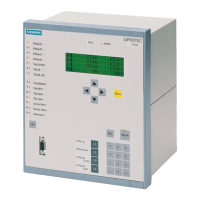'(& )( )'& &) ( &!& ")& &$(( $# Ć %&( $# #)" &&#$
4 - 31
Siemens AG ⋅ May 1998
4.7.6 Event logging
After a fault in the network, information concerning
the response of the protection device and the meaĆ
sured values are important for an exact analysis of
the fault. For this purpose the master unit of the
7SS52 contains a memory for fault events (maximum
40 events).
Operational events (e.g. isolator operations) are regisĆ
tered in an operational events memory (up to 99
events).
In addition events and states can be indicated via
alarm relays and optically via LEDs in the master unit
and the bay units.
4.7.6.1 Alarm relays and indications
The master unit can be fitted with up to two alarm
modules (EAZ1 and EAZ2). On each module 16 alarm
relays are available for remote signalling. Functions
can be allocated to them out of an alarm list.
The alarm relays are unstored and reset after the inĆ
itiating criterion disappears. On the device's frontplate
an optical indication (LED) is provided for each alarm.
The bay unit has 10 LEDs which, pre-set ex works,
serve for indication of the isolator states (pre-set
CLOSED-red;OPEN-green). Further 6 LEDs indicate
protection functions. An alarm relay serves for indicaĆ
tion of alarms. The LEDs and alarm relays can at ranĆ
dom be marshalled with different functions. The pre-
set functions are listed in chapter 6.4.2.4.
Bay unit and master unit have a reset button for local
reset of the LED indications. Operating the reset butĆ
ton on the master unit resets all LED indications on all
connected bay units.
Configurable binary inputs ">LED-ackn" can be used
in the master unit and bay units for remote reset. In
addition to the LEDs for alarm indication, each type of
device contains an indication "ready for operation"
(green) and a failure indication (red).
4.7.6.2 Operation and indication
Operational measured values, operational events and
fault events can be read out via integrated operation
keys and a LC display. The keypad can also be used
for setting protection parameters, configuring the proĆ
tected object and marshalling binary inputs and outĆ
puts.
The master unit has a front-side interface for connecĆ
ting a PC. Utilizing the communication program
DIGSI, menu-guided communication with the protecĆ
tion system is provided. Fault records can be read out
and analysed.
The 7SS52 stores up to 40 fault events and 99 operaĆ
tional events. When the event buffer is full, the oldest
events are overwritten (ring buffer).
The recordable operations and fault events are listed
in annex A.1.2.
Operational measured values (feeder currents, stabiliĆ
zing and differential currents) are displayed in the maĆ
ster unit (full range) and in the bay units (bay-related
measured values) for the purpose of commissioning
and test support.
Master unit
D Feeder currents
L1
,
L2
,
L3
of all configured bay
units
D Stabilizing and differential currents per phase seĆ
gregated for ZPS-BSZ1 (DA 7400/ZE), ZPS-BSZ2
(DA 7500/ZE) and ZPS-BSZ3 (DA 7600/ZE) for all
bus zones.
Bay unit
D Feeder currents
L1
,
L2
,
L3
,
E
D Stabilizing and differential currents per phase of
the check zone
D Frequency [Hz] (indication for
0,1
N
)
The indicated measured values are refreshed at a
rate of 0.5 sec.
The actual isolator replica is available for graphical or
tabled indication through DIGSI and the operation inĆ
terface of the master unit.
In addition, the configured plant can be displayed graĆ
phically.

